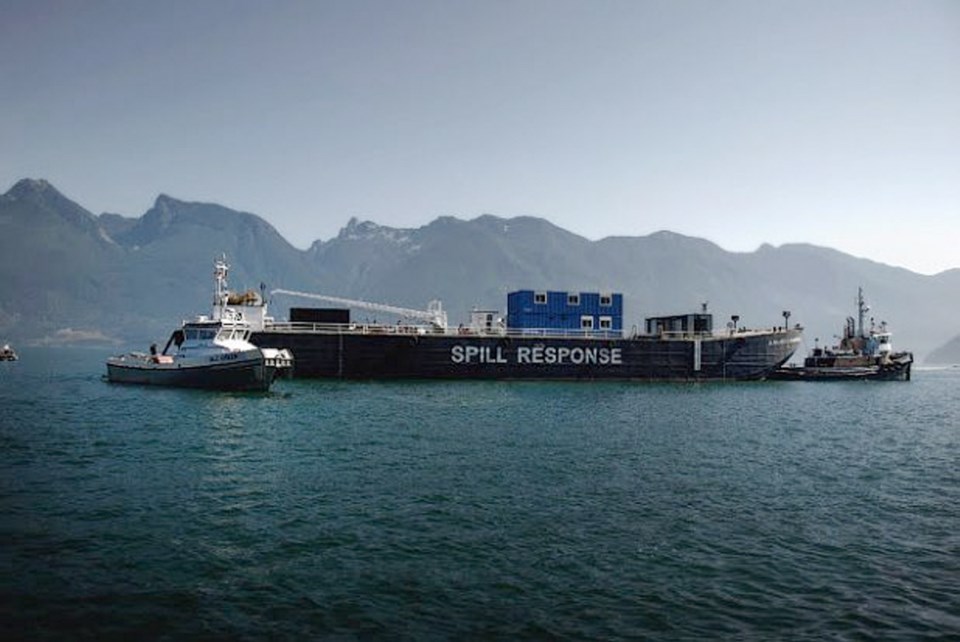 The nightmare scenario in many people’s minds concerning the Trans Mountain Pipeline is a tanker spill in the Salish Sea.
The nightmare scenario in many people’s minds concerning the Trans Mountain Pipeline is a tanker spill in the Salish Sea.
It would legitimately qualify as a catastrophe. In fact, some interveners during the hearing process argued for a catastrophe bond to transfer some of the risks associated with a spill.
But in the hundreds of pages of the National Energy Board’s approval of the line, the panel discounts the chances of it happening to the point where it is considered a very remote possibility.
The risk has galvanized a lot of the opposition to the project, but it didn’t stop the NEB from recommending approval of the line last week. The panel considered and discussed the issue at length and concluded it’s simply not likely.
The sailing route tankers would take from the Burnaby terminal to the high seas at the entrance to the Juan de Fuca Strait is considered a relatively uncomplicated trip. The most challenging part is right in Vancouver Harbour.
Trans Mountain’s outline considers the weather and oceanographic conditions to be mild. The only delays or course changes would be due to fog.
“The Pacific Pilotage Authority has not had to abort a transit due to poor weather since its inception,” the NEB report said.
The company stressed the global safety record in the marine industry has improved continuously over 40 years. The incident frequency for oil tankers was among the lowest for all marine vessels from 2002 to 2011. Over that time period there was only one tanker incident on the West Coast, and no oil was released. The number of spills worldwide declined between 1970 and 2012, despite the vast increase in the volume transported.
It’s due to double hulls, improved reliability of machinery, improved navigational aids and improved risk management. Tankers have operated out of the terminal in Burnaby for 60 years with no oil-pollution incident from tanker operations. The company would not operate the tankers, which would be chartered by the shippers, but they would all have to meet high standards.
Inbound tankers would pick up pilots just off Victoria, and the pilots would be in command right to the terminal. After loading, two pilots would be required to navigate out of Canadian waters, one to ensure safe transit and one to monitor the bridge crew and ship systems.
It would take at least three tugs to accompany a tanker through most of the harbour. They would fall away, but another tug would meet the ship at Saturna Island and accompany it to Victoria, where the pilots would disembark. The tug would go as far as Race Rocks.
No pilot or tug is required through Juan de Fuca Strait, but ships are monitored, and U.S. companies maintain a rescue tug at Neah Bay.
A number of interveners stressed that even with those safety measures and others, the risk is too great, but the panel disputed some of the risk assessments using during hearings.
If the unthinkable did happen, the NEB panel noted pessimistic predictions about cleanup efforts. One expert said that based on past major spills, a large spill could never be entirely or even largely contained, even with the best equipment, training and will in the world.
Nonetheless, planning is underway to enhance spill-response capabilities along the route, aiming for more assets and faster response times, at a cost of $100 million.
Various impacts on wildlife are acknowledged if a spill were to occur, but the board found the marine environment and most species would recover naturally in two to 10 years.
Through a tiered, international insurance system, there is a maximum of $1.3 billion available to cover the cost of response, cleanup and compensation following a major spill. But Trans Mountain wouldn’t consider itself responsible for any tanker spill. The liability would rest with the ship owner.
Interveners argued the long-term cost of a spill could be higher than $1.3 billion. The panel didn’t reach any conclusions on that argument because the marine aspect is outside its jurisdiction.
It might be outside the NEB’s direct authority, but it’s top of mind with a lot of people who live near the tanker routes.



